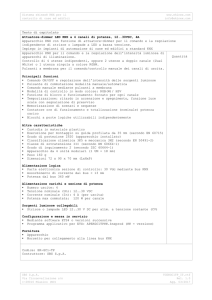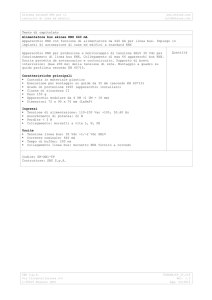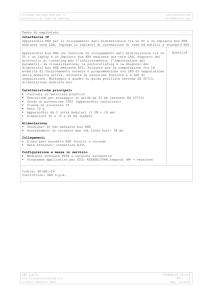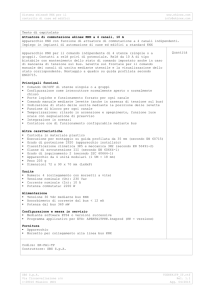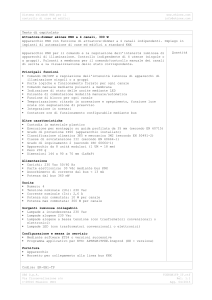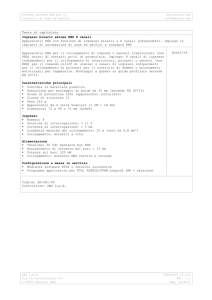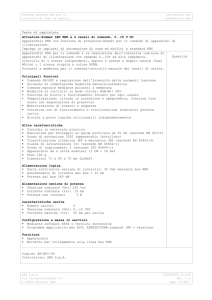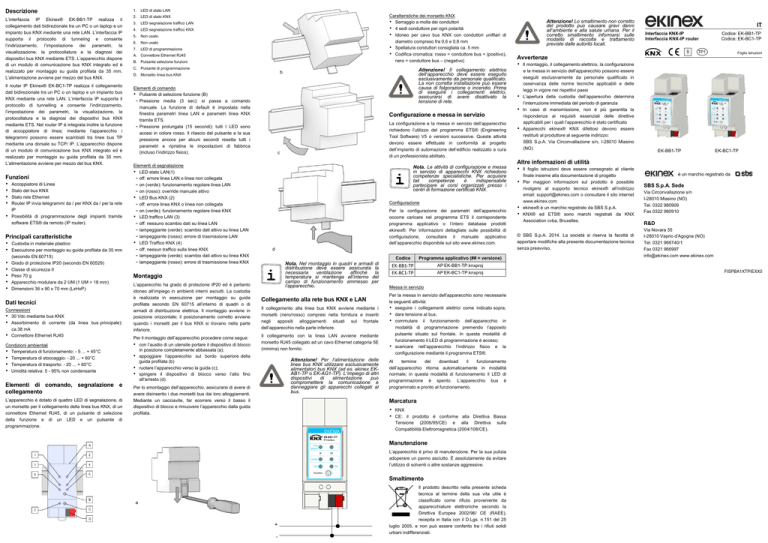
Descrizione
1.
LED di stato LAN
L’interfaccia IP Ekinex® EK-BB1-TP realizza il
collegamento dati bidirezionale tra un PC o un laptop e un
impianto bus KNX mediante una rete LAN. L’interfaccia IP
supporta il protocollo di tunneling e consente
l’indirizzamento, l’impostazione dei parametri, la
visualizzazione, la protocollatura e la diagnosi dei
dispositivi bus KNX mediante ETS. L’apparecchio dispone
di un modulo di comunicazione bus KNX integrato ed è
realizzato per montaggio su guida profilata da 35 mm.
L’alimentazione avviene per mezzo del bus KNX.
2.
LED di stato KNX
3.
LED segnalazione traffico LAN
4.
LED segnalazione traffico KNX
Il router IP Ekinex® EK-BC1-TP realizza il collegamento
dati bidirezionale tra un PC o un laptop e un impianto bus
KNX mediante una rete LAN. L’interfaccia IP supporta il
protocollo di tunnelling e consente l’indirizzamento,
l’impostazione dei parametri, la visualizzazione, la
protocollatura e la diagnosi dei dispositivi bus KNX
mediante ETS. Nel router IP è integrata inoltre la funzione
di accoppiatore di linea; mediante l’apparecchio i
telegrammi possono essere scambiati tra linee bus TP
mediante una dorsale su TCP/ IP. L’apparecchio dispone
di un modulo di comunicazione bus KNX integrato ed è
realizzato per montaggio su guida profilata da 35 mm.
L’alimentazione avviene per mezzo del bus KNX.
Funzioni
• Accoppiatore di Linea
• Stato del bus KNX
• Stato rete Ethernet
• Router IP invia telegrammi da / per KNX da / per la rete
•
IP
Possibilità di programmazione degli impianti tramite
software ETS® da remoto (IP router).
Principali caratteristiche
• Custodia in materiale plastico
• Esecuzione per montaggio su guida profilata da 35 mm
•
•
•
•
•
(secondo EN 60715)
Grado di protezione IP20 (secondo EN 60529)
Classe di sicurezza II
Peso 70 g
Apparecchio modulare da 2 UM (1 UM = 18 mm)
Dimensioni 36 x 90 x 70 mm (LxHxP)
Dati tecnici
Connessioni
• 30 Vdc mediante bus KNX
• Assorbimento di corrente (da linea bus principale):
ca.38 mA
• Connettore Ethernet RJ45
Condizioni ambientali
• Temperatura di funzionamento: - 5 ... + 45°C
• Temperatura di stoccaggio: - 20 ... + 60°C
• Temperatura di trasporto: - 20 ... + 60°C
• Umidità relativa: 5 - 95% non condensante
Elementi di comando, segnalazione e
collegamento
L’apparecchio è dotato di quattro LED di segnalazione, di
un morsetto per il collegamento della linea bus KNX, di un
connettore Ethernet RJ45, di un pulsante di selezione
della funzione e di un LED e un pulsante di
programmazione.
5.
Non usato
6.
Non usato
7.
LED di programmazione
Caratteristiche dei morsetto KNX
• Serraggio a molla dei conduttori
• 4 sedi conduttore per ogni polarità
• Idoneo per cavo bus KNX con conduttori unifilari di
diametro compreso fra 0,6 e 0,8 mm
• Spellatura conduttori consigliata ca. 5 mm
• Codifica cromatica: rosso = conduttore bus + (positivo),
nero = conduttore bus – (negativo)
A. Connettore Ethernet RJ45
B. Pulsante selezione funzioni
C. Pulsante di programmazione
Elementi di comando
• Pulsante di selezione funzione (B)
- Pressione media (3 sec): si passa a comando
manuale. La funzione di default è impostata nella
finestra parametri linea LAN e parametri linea KNX
tramite ETS.
- Pressione prolungata (15 secondi): tutti I LED sono
accesi in colore rosso. Il rilascio del pulsante e la sua
pressione ancora per alcuni secondi resetta tutti i
parametri e ripristina le impostazioni di fabbrica
(incluso l’indirizzo fisico).
Elementi di segnalazione
• LED stato LAN(1)
- off: errore linea LAN o linea non collegata
- on (verde): funzionamento regolare linea LAN
- on (rosso): override manuale attivo
• LED Bus KNX (2)
- off: errore linea KNX o linea non collegata
- on (verde): funzionamento regolare linea KNX
• LED traffico LAN (3)
- off: nessuno scambio dati su linea LAN
- lampeggiante (verde): scambio dati attivo su linea LAN
- lampeggiante (rosso): errore di trasmissione LAN
• LED Traffico KNX (4)
- off: nessun traffico sulla linea KNX
- lampeggiante (verde): scambio dati attivo su linea KNX
- lampeggiante (rosso): errore di trasmissione linea KNX
Montaggio
L’apparecchio ha grado di protezione IP20 ed è pertanto
idoneo all’impiego in ambienti interni asciutti. La custodia
è realizzata in esecuzione per montaggio su guida
profilata secondo EN 60715 all’interno di quadri o di
armadi di distribuzione elettrica. Il montaggio avviene in
posizione orizzontale; il posizionamento corretto avviene
quando i morsetti per il bus KNX si trovano nella parte
inferiore.
Per il montaggio dell’apparecchio procedere come segue:
• con l’ausilio di un utensile portare il dispositivo di blocco
in posizione completamente abbassata (a);
• appoggiare l’apparecchio sul bordo superiore della
guida profilata (b)
• ruotare l’apparecchio verso la guida (c);
• spingere il dispositivo di blocco verso l’alto fino
all’arresto (d).
Attenzione! Il collegamento elettrico
dell’apparecchio deve essere eseguito
esclusivamente da personale qualificato.
La non corretta installazione può essere
causa di folgorazione o incendio. Prima
di eseguire i collegamenti elettrici,
assicurarsi di avere disattivato la
tensione di rete.
b
D. Morsetto linea bus KNX
Attenzione! Lo smaltimento non corretto
del prodotto può causare gravi danni
all’ambiente e alla salute umana. Per il
corretto smaltimento informarsi sulle
modalità di raccolta e trattamento
previste dalle autorità locali.
S
•
•
c
i
Nota. Le attività di configurazione e messa
in servizio di apparecchi KNX richiedono
competenze specialistiche. Per acquisire
tali
competenze
è
indispensabile
partecipare ai corsi organizzati presso i
centri di formazione certificati KNX.
Configurazione
Per la configurazione dei parametri dell’apparecchio
occorre caricare nel programma ETS il corrispondente
programma applicativo o l’intero database prodotti
ekinex®. Per informazioni dettagliate sulle possibilità di
configurazione, consultare il manuale applicativo
dell’apparecchio disponibile sul sito www.ekinex.com.
d
i
Nota. Nel montaggio in quadri e armadi di
distribuzione deve essere assicurata la
necessaria
ventilazione
affinché
la
temperatura si mantenga all’interno del
campo di funzionamento ammesso per
l’apparecchio.
Collegamento alla rete bus KNX e LAN
Il collegamento alla linea bus KNX avviene mediante i
morsetti (nero/rosso) compresi nella fornitura e inseriti
negli appositi alloggiamenti situati sul frontale
dell’apparecchio nella parte inferiore.
Il collegamento con la linea LAN avviene mediante
morsetto RJ45 collegato ad un cavo Ethernet categoria 5E
(minima) non fornito.
Attenzione! Per l’alimentazione delle
linee bus KNX utilizzare esclusivamente
alimentatori bus KNX (ad es. ekinex EKAB1-TP o EK-AG1-TP). L’impiego di altri
dispositivi
di
alimentazione
può
compromettere la comunicazione e
danneggiare gli apparecchi collegati al
bus.
Per lo smontaggio dell’apparecchio, assicurarsi di avere di
avere disinserito i due morsetti bus dai loro alloggiamenti.
Mediante un cacciavite, far scorrere verso il basso il
dispositivo di blocco e rimuovere l’apparecchio dalla guida
profilata.
Codice
Programma applicativo (## = versione)
EK-BB1-TP
EK-BC1-TP
AP EK-BC1-TP.knxproj
Messa in servizio
Per la messa in servizio dell’apparecchio sono necessarie
le seguenti attività:
• eseguire i collegamenti elettrici come indicato sopra;
• dare tensione al bus;
• commutare il funzionamento dell’apparecchio in
modalità di programmazione premendo l’apposito
pulsante situato sul frontale. In questa modalità di
funzionamento il LED di programmazione è acceso;
• scaricare nell’apparecchio l’indirizzo fisico e la
configurazione mediante il programma ETS®.
Al
termine
del
download
il
funzionamento
dell’apparecchio ritorna automaticamente in modalità
normale; in questa modalità di funzionamento il LED di
programmazione è spento. L’apparecchio bus è
programmato e pronto al funzionamento.
è conforme alla Direttiva Bassa
Tensione (2006/95/CE) e alla Direttiva sulla
Compatibilità Elettromagnetica (2004/108/CE).
Manutenzione
L’apparecchio è privo di manutenzione. Per la sua pulizia
adoperare un panno asciutto. È assolutamente da evitare
l’utilizzo di solventi o altre sostanze aggressive.
Smaltimento
+
-
TP1
Foglio istruzioni
•
e la messa in servizio dell’apparecchio possono essere
eseguiti esclusivamente da personale qualificato in
osservanza delle norme tecniche applicabili e delle
leggi in vigore nei rispettivi paesi
L’apertura della custodia dell’apparecchio determina
l’interruzione immediata del periodo di garanzia
In caso di manomissione, non è più garantita la
rispondenza ai requisiti essenziali delle direttive
applicabili per i quali l’apparecchio è stato certificato
Apparecchi ekinex® KNX difettosi devono essere
restituiti al produttore al seguente indirizzo:
SBS S.p.A. Via Circonvallazione s/n, I-28010 Miasino
(NO)
EK-BB1-TP
EK-BC1-TP
Altre informazioni di utilità
• Il foglio istruzioni deve essere consegnato
•
•
•
al cliente
finale insieme alla documentazione di progetto
Per maggiori informazioni sul prodotto è possibile
rivolgersi al supporto tecnico ekinex® all’indirizzo
email: [email protected] o consultare il sito internet
www.ekinex.com
ekinex® è un marchio registrato da SBS S.p.A.
KNX® ed ETS® sono marchi registrati da KNX
Association cvba, Bruxelles.
© SBS S.p.A. 2014. La società si riserva la facoltà di
apportare modifiche alla presente documentazione tecnica
senza preavviso.
è un marchio registrato da
SBS S.p.A. Sede
Via Circonvallazione s/n
I-28010 Miasino (NO)
Tel. 0322 980909
Fax 0322 980910
R&D
Via Novara 35
I-28010 Vaprio d’Agogna (NO)
Tel. 0321 966740/1
Fax 0321 966997
[email protected] www.ekinex.com
AP EK-BB1-TP.knxproj
Marcatura
• KNX
• CE: il prodotto
a
Codice: EK-BB1-TP
Codice: EK-BC1-TP
Avvertenze
• Il montaggio, il collegamento elettrico, la configurazione
Configurazione e messa in servizio
La configurazione e la messa in servizio dell’apparecchio
richiedono l’utilizzo del programma ETS® (Engineering
Tool Software) V5 o versioni successive. Queste attività
devono essere effettuate in conformità al progetto
dell’impianto di automazione dell’edificio realizzato a cura
di un professionista abilitato.
IT
Interfaccia KNX-IP
Interfaccia KNX-IP router
Il prodotto descritto nella presente scheda
tecnica al termine della sua vita utile è
classificato come rifiuto proveniente da
apparecchiature elettroniche secondo la
Direttiva Europea 2002/96/ CE (RAEE),
recepita in Italia con il D.Lgs. n.151 del 25
luglio 2005, e non può essere conferito tra i rifiuti solidi
urbani indifferenziati.
FISPBA1XTPIEXX0
Description
The Ekinex® EK-BB1-TP IP interface realizes the
bidirectional data link between a PC or laptop and a KNX
system via LAN. The interface supports IP tunneling
protocol and enables addressing, setting parameters,
viewing and diagnosis of KNX devices via ETS. The
device has an integrated KNX bus communication module
and is designed for 35mm rail mounting. Power is
supplied via the KNX bus.
The Ekinex® EK-BC1-TP IP router realizes the
bidirectional data link between a PC or laptop and a KNX
system via LAN. The interface supports IP tunneling
protocol and enables addressing, setting parameters,
viewing and diagnosis of KNX devices via ETS.
The IP router also integrates the function of a line coupler;
telegrams can be exchanged between TP bus lines
through a bridge over TCP/IP. The device has an
integrated KNX bus communication module and is
designed for 35mm rail mounting. The device is powered
by a 30 Vdc SELV voltage via the KNX bus and does not
require auxiliary power but, when sizing the bus line, you
need to consider this as a supply equivalent to 4 devices
of 10 mA.
Function
• Line coupler
• KNX bus status
• Ethernet bus status
• IP router sends telegrams
•
from / to KNX from / to IP
network
Programmable plant via software ETS® remotely (IP
router)
Main characteristics
• Housing in plastic material
• Mounting on 35 mm rail (according to EN 60715)
• Protection degree IP20 (according to EN 60529)
• Safety class II
• Weight 70 g
• 2 modular units (1 unit = 18 mm)
• Dimensions 36 x 90 x 70 mm (WxHxD)
Technical data
Connections
• 30 Vdc from KNX bus line
• Current consumption (from main bus line): about 38
mA
• RJ45 ethernet connector
Environmental conditions
• Operating temperature: - 5 ... + 45°C
• Storage temperature: - 20 ... + 60°C
• Transport temperature: - 20 ... + 60°C
• Relative humidity: 5 - 95% not condensing
Switching,
elements
display
and
connection
1.
LAN status LED
2.
KNX status LED
3.
LAN traffic LED
4.
KNX traffic LED
5.
Not used
6.
Not used
7.
Programming LED
Characteristics of the KNX terminal bock
• Spring clamping of conductors
• 4 seats for conductors for each polarity
• Terminal suitable for KNX bus cable with single-wire
conductors and diameter between 0.6 and 0.8 mm
• Recommended wire stripping approx. 5 mm
• Color codification: red = + (positive) bus conductor,
• black = - (negative) bus conductor
A. Ethernet connector
B. Function pushbutton
C. Programming pushbutton
Warning! The electrical connection of
the device can be carried out only by
qualified personnel. The incorrect
installation may result in electric shock
or fire. Before making the electrical
connections, make sure the power
supply has been turned off.
b
D. KNX bus connector
Command elements
• Function pushbutton (B)
- Long press (3 seconds): switch to manual control. The
default function is set with LAN line and KNX line
parameters through ETS.
- Very long press (15 seconds): all LEDs are red.
Release button and press again for some seconds:
resets all the parameter to factory default (incl. physical
address).
Display elements
• LAN status LED (1)
- off: LAN error or line not connected
- on (green): LAN normal operation
- on (red): manual override active
• KNX status LED (2)
- off: KNX error or line not connected
- on (green): KNX normal operation
• LAN traffic LED (3)
- off: no data exchange on LAN line
- blinking (green): data exchange active on LAN
- blinking (red): LAN transmission error
• KNX traffic LED (4)
- off: no data exchange on KNX line
- blinking (green): data exchange active on KNX
- blinking (red): KNX transmission error
Configuration and commissioning
Configuration and commissioning of the device require the
use of the ETS® (Engineering Tool Software) program V5
or later releases. These activities must be carried out
according to the design of the building automation system
done by a qualified planner.
c
i
For the configuration of the device parameters the
corresponding application program or the whole ekinex®
pro- duct database must be loaded in the ETS program.
For detailed information on configuration options, refer to
the application manual of the device available on the
website www.ekinex.com.
Code
For the installation of the device on the rail proceed as
follows:
• with the aid of a tool bring the locking device in the fully
lowered position (a);
• place the upper edge of the rear inner profile on the
• upper edge of the rail (b);
• rotate the device towards the rail (c);
• push the locking device upward until it stops (d).
Application program (## = release)
EK-BB1-TP
EK-BC1-TP
d
i
Note. When mounting the device in boards
and cabinets it shall be provided the
necessary
ventilation
so
that
the
temperature can be kept within the
operating range of the device.
Connection of the KNX bus line and LAN
The connection to the KNX bus line is made by the
terminal blocks (black/red) included in the supply and
inserted into the slots located on the bottom part of the
front.
The connection to the LAN line is made via the RJ45
terminal connected to an Ethernet cable (minimum
category 5E – not supplied).
Warning! In order to supply the KNX
bus line, use only a KNX bus power
supply (e.g. ekinex EK-AB1-TP or EKAG1-TP). The use of other power
supplies
can
compromise
the
communication and damage the devices
connected to the bus.
Before removing the device, be sure the bus terminals
have been extracted from their slots. Use a screwdriver to
slide down the locking device and remove the device from
the rail.
AP EK-BB1-TP.knxproj
For commissioning the device the following activities are
required:
•
•
•
make the electrical connections as described above;
•
download into the device the physical address and the
configuration with ETS® program.
turn on the bus power supply;
switch to programming mode by pressing the
programming pushbutton located on the front side of
the housing. During this operating mode, the
programming LED is turned on;
At the end of the download the operation of the device
automatically returns to normal mode; in this mode the
programming LED is turned off. Now the bus device is
programmed and ready for use.
Marks
• KNX
• CE: the device complies with the Low Voltage Directive
The line/area coupler is equipped with 4 LEDs and a
function pushbutton located on the front of the device, 1
bus terminal for KNX bus line, 1 RJ45 connector for
Ethernet LAN, a programming LED and a programming
pushbutton.
(2006/95/EC) and the Electromagnetic Compatibility
Directive (2004/108/EC).
Maintenance
The device is maintenance-free. To clean it use a dry
cloth. It must be avoided the use of solvents or other
aggressive substances.
Disposal
At the end of its useful life the product
described in this datasheet is classified as
waste from electronic equipment in
accordance with the European Directive
2002/96/EC (RAEE), and cannot be
disposed together with the municipal
undifferentiated solid waste.
a
+
-
Product code: EK-BB1-TP
Product code: EK-BC1-TP
S
TP1
Instructions
•
•
•
electrical connection, configuration and
commissioning of the device can only be carried out by
qualified personnel in compliance with the applicable
technical standards and laws of the respective
countries;
Opening the housing of the device causes the
immediate end of the warranty period;
In case of tampering, the compliance with the essential
requirements of the applicable directives, for which the
device has been certified, is no longer guaranteed;
ekinex® KNX defective devices must be returned to the
manufacturer at the following address: SBS S.p.A. Via
Circonvallazione s/n, I-28010 Miasino (NO) Italy
Other information
• This datasheet is
•
•
•
•
aimed at installers, system
integrators and planners
For further information on the product, please contact
the ekinex® technical support at the e-mail address:
[email protected]
or
visit
the
website
www.ekinex.com
Each ekinex® device has a unique serial number on
the label. The serial number can be used by installers
or system integrators for documentation purposes and
has to be added in each communication addressed to
the SBS technical support in case of malfunctioning of
the device
ekinex® is a registered trademark of SBS S.p.A.
KNX® and ETS® are registered trademarks of KNX
Association cvba, Bruxelles.
AP EK-BC1-TP.knxproj
Commissioning
IT
KNX-IP Interface
KNX-IP Router
Warnings
• Installation,
Configuration
Mounting
The device has degree of protection IP20, and is therefore
suitable for use in dry interior rooms. The housing is made
for rail mounting according to EN 60715 in boards or
cabinets for electrical distribution. The installation is in
horizontal position; the correct position is when the KNX
bus terminals are located at the bottom.
Note. The configuration and commissioning
of KNX devices require specialized skills.
To acquire these skills, you should attend
the workshops at KNX cer- tified training
centers.
Warning! Incorrect disposal of this
product may cause serious damage to
the environment and human health.
Please be informed about the correct
disposal procedures for waste collecting
and processing provided by local
authorities.
EK-BB1-TP
EK-BC1-TP
is a registered trademark of
SBS S.p.A. Sede
Via Circonvallazione s/n
I-28010 Miasino (NO)
Tel. 0322 980909
Fax 0322 980910
R&D
Via Novara 35
I-28010 Vaprio d’Agogna (NO)
Tel. 0321 966740/1
Fax 0321 966997
[email protected] www.ekinex.com
© SBS S.p.A. 2014. The company reserves the right to
make changes to this documentation without notice.
FISPBA1XTPIEXX0

